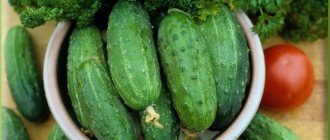Tomatoes are a favorite vegetable for many, used as the main component of salads and as an addition to hot dishes. At the end of the season, I really want to find the best way to store tomatoes so that they remain juicy and tasty longer. In our article we will talk about how to properly preserve the harvest of ripe tomatoes at home, and also talk about storing green fruits at the ripening stage.
You can store both ripe and unripe tomatoes at home.
Varieties for long-term storage
To ensure that the harvest is stored for a long time, those varieties that are characterized by high shelf life are selected for planting. Tomatoes are not washed; heavily soiled ones are wiped with a soft cloth, trying not to spoil the skin.
Experienced vegetable growers harvest slightly unripe tomatoes of the following varieties:
- De Barao is a mid-season tomato, the height of the bush reaches 3 m. The fruits are oblong, of different colors - from yellow to brown.
- San Marzano is a variety with dense, juicy fruits of bright red color, plum-shaped, weighing up to 140 g.
- Rio Grande is a mid-season variety with high yield.
There are special varieties and hybrids bred for long-term storage:
- Giraffe is a variety that reaches a height of 1.2 m. It is a late-ripening variety and is cultivated in open ground and under film covers. The fruits are stored until the end of spring.
- Long Keeper is a late-ripening variety, tomatoes reach 450 g. They are stored fresh until spring.
- Masterpiece-1 is a late-ripening, low-growing hybrid; its bush grows up to 65 cm. Red, flat fruits weighing about 200 g are stored until March.
Note
If you have learned how to keep tomatoes fresh using boxes and paper, and decide to use this method, remember that periodically, about once a week, you need to sort through the fruits, take away ripe, overripe, and damaged ones. The same thing is that red tomatoes need to be separated from green ones, since unripe vegetables are not so saturated with folic acid, which contributes to the rapid reddening and ripening of the fruit. And we need to slow down this process. You know about the trick: “If you want green tomatoes to ripen faster, be sure to add a few red tomatoes to them.” Therefore, red tomatoes need to be quickly removed from green ones.
It is also necessary to inspect tomatoes for rot, so that one tomato does not infect the others. Change the paper, it becomes damp, and this is contraindicated for long-term storage. Keep an eye on the boxes and your tomatoes will be stored until spring.
If you have straw, then it is better to lay it on the bottom of the box; it is advisable to periodically change it for a new, dry one. Straw generally helps housewives to preserve ripe, tasty vegetables until the New Year holidays, especially in the matter of how to keep tomatoes fresh. Therefore, stock up on it and get rid of disposable plastic bags. They collect moisture and spoil the tomatoes.
You can use all the ways to keep tomatoes fresh. That is, put green or slightly ripe fruits in boiling water for 2 minutes, dry, wipe with alcohol, wrap in paper, fold with the roots up in a row, in two layers, sprinkle with sawdust and cover with straw. This way, in the spring, before the season starts, you will be able to eat delicious, aromatic tomatoes.
How to properly harvest tomatoes for storage
The harvest is harvested before night frosts, since frozen fruits will not be stored for long. Basic collection rules:
- tomatoes are harvested during the day, when there is no morning dew on them;
- to extend shelf life, the collected fruits are sorted;
- choose only ripe vegetables and fruits ripened to milky ripeness;
- All collected tomatoes are wiped with alcohol for disinfection.
How to help fruits ripen
If you need green tomatoes picked from the bush to ripen faster, the following trick will help. Thanks to her, the fruits will ripen in a week.
Green fruits should be placed in a well-lit place. The temperature should be above 25 degrees. These conditions will help the vegetables ripen quickly without spoiling.
In an apartment, green tomatoes can be laid out directly on the windowsill. The sun's rays and warmth will do their job.
How to store the harvest
Fleshy, sugary tomatoes are the worst to store, as they quickly begin to ferment and become unsuitable for consumption. Slightly unripe tomatoes stay fresh for 2-3 days longer than ripe ones because their flesh is still hard. Overripe fruits are eaten immediately, as they do not last long.
On a note . Regardless of the variety, tomatoes grown outdoors are better preserved than those grown in greenhouses.
How to store tomatoes in a cellar or basement
The suitable temperature for maintaining the freshness of tomatoes is +10-15°C, so the best place to store picked tomatoes is a basement or cellar. In the cellar, tomatoes are placed in wooden boxes in layers, separating the layers with paper. If possible, each tomato is wrapped in paper wrapper. Do not put more than three layers in boxes, otherwise the bottom row will deteriorate from the weight of the top ones.
If there is no cellar, then vegetables are stored on the floor - for example, in a pantry. Unripe tomatoes are left at room temperature, where they ripen over time.
Features of storage on the balcony
A suitable place to store ripe tomatoes is a balcony if the air temperature does not exceed +15°C. Tomatoes are stored there in the same way as in a cellar or basement: they are laid in layers, each layer covered with cloth or paper. The boxes themselves are also covered with fabric to protect them from sunlight.
How to store fresh tomatoes in jars
Canning is a method of long-term storage. In jars, tomatoes remain usable for 4-6 months.
Ripe tomatoes are washed and dried, then placed in a three-liter sterilized jar. Pour 3-4 tbsp. l. alcohol, cover with a nylon lid and shake so that all the tomatoes are well wet. Then a thread soaked in alcohol is placed in the middle and set on fire from the outside. When the alcohol starts to burn, immediately cover the jar with a metal lid.
On a note. For long-term storage, jars are placed in a cool, dark place.
In boxes
Tomatoes are kept in wooden boxes with slits to allow oxygen to reach them. The boxes are covered with gauze or cotton cloth, but not with a lid. There should be no foreign odors in the container. To protect the tomatoes from moisture, dry hay is placed at the bottom.
In the sawdust
To keep tomatoes in boxes longer, use sawdust. If the crop is still slightly unripe, it is placed in boxes, if possible in wooden ones, with the top to the top (where the stalk was - this is the top). Under each layer, paper is placed and sawdust is poured, which will absorb moisture and protect the fruits from rot.
To make this storage method more effective, the boxes are placed in a dry and dark place at an air temperature of no more than +10-15°C. It is better to store tomatoes in the cellar, basement or on the balcony if the side is not sunny. The box is covered with gauze or paper.
Indoor storage
Ripe tomatoes are poorly stored at temperatures higher than +22°C. Because tomatoes contain a lot of sugar and juice, warm conditions create a favorable environment for fermentation. Fleshy fruits with a thin peel are stored at room temperature for no more than 2-3 days. If the tomato has a thick shell and dense pulp, then the vegetables will be stored for up to 6-7 days.
Important! To avoid poisoning from stale products, tomatoes should not be stored at room conditions for longer than this period.
In paper
If the fruits are in newspaper or paper, they will be stored for a long time not only in the refrigerator, but also in a box or basket. The main thing is not to put a large number of tomatoes on top of each other; 1-2 layers will be enough.
Storing in a pan
For long-term storage, tomatoes are pickled in a saucepan. To do this, cut half of the tomatoes into equal parts. Place a layer of chopped vegetables in a pan, sprinkle with salt, then a layer of whole ones. And so on several times until the container is completely filled.
On a note. Regardless of the method you choose, inspect your inventory periodically. If a tomato begins to spoil, remove it immediately so that it does not infect others.
In jars with mustard
The tomatoes are thoroughly washed with hot water and dried. Pour 2 tbsp into a sterilized jar. l. mustard powder. Tomatoes are placed in it and each layer is sprinkled with mustard. A three-liter jar should take no more than 7 tbsp. l. powder. The jar is sealed and stored in a cool place.
Determining factors for proper storage of tomatoes
Not every tomato variety can be stored for a long time. Therefore, breeders have identified a special gene responsible for delayed fruit ripening. Such hybrid varieties of tomatoes can be more easily transported, and their storage duration varies from 30 days or more. The very first representative among tomatoes is considered to be the Giraffe variety. Later, experts developed other varieties with different shelf life:
| 2-3 months | 3-5 months | 6-7 months |
| New masterpiece | New Year | Lyn Keeper |
| Oak | Red Stone | Giraffe |
| Lunar | Podzimny | Orange Ball |
| Japanese crab | Rio Grande | Vasilisa |
| Dominator | Kyrgyz late | |
| Radical | ||
| Lazarus |
A notable feature of mature tomato varieties is their color. When ripe, the peel turns orange, while the flesh becomes bright red.
Storage duration
Ripe tomatoes can last for a week if stored at a temperature of 1-2° C. The refrigerator is not able to preserve the strength of fresh tomatoes for a long time. The maximum period is up to 3 days. Therefore, the best option for storing tomatoes would be to place the unripe fruit on the refrigerator shelf. Green tomatoes can be kept in such conditions for a couple of weeks.
Creating conditions for ripening
Depending on certain storage conditions, the shelf life of fresh tomatoes may vary.
Therefore, by creating a cozy microclimate for tomatoes, their “life” can be extended for a considerable time.
The ideal conditions for storing fruits without loss of taste are:
- temperature within 10-12°C;
- humidity not exceeding 80-85%;
- absence of light rays.
During storage, fruits evaporate excess moisture, so regular ventilation of the room becomes a decisive factor in protecting tomatoes from spoilage. It is important to timely select damaged and ripe fruits.
Fresh harvest storage area
When choosing a suitable place for storing fresh tomatoes, you should take into account the optimal storage conditions for the fruit. Based on this, the best option would be:
- cellar or basement in a private house;
- garage, if it is free of dampness and toxic substances;
- balcony or loggia in the apartment;
- bathroom while maintaining optimal conditions;
- dark unheated room or pantry.
Cold storage
Where is the best place to store ripe tomatoes? Using regular newspaper, tomatoes can be stored in the refrigerator for up to two weeks. Each vegetable is wrapped in a paper bundle or combined in three pieces into an envelope. The goal is to keep the tomatoes from getting soggy. The optimal place to store tomatoes in the refrigerator is the bottom shelf for vegetables. The newspaper is changed periodically, and the shelf in the refrigerator is wiped dry.
On a note . Do not store tomatoes in a closed plastic bag, as they can quickly spoil due to condensation.
But when stored in the refrigerator, tomatoes lose their fresh taste. The volatile substances they contain, which give the aroma and familiar taste, do not withstand low temperatures and are destroyed.
Storage conditions and location
To preserve tomatoes for a long time, you must adhere to temperature and humidity conditions. +8–10 degrees are considered optimal, with an air humidity of 80%.
Tomatoes are very sensitive to sudden changes in temperature, and if the thermal balance is disturbed, they become lethargic and lose their unforgettable aroma.
The location chosen for storage also plays an important role. Any dark room is suitable for this: a basement, a pantry, a closed vegetable compartment in the refrigerator, or the space under the bed.
Storing Processed Tomatoes
Tomatoes are not only stored fresh. Heat-treated, long-storable fruits are used for food. In terms of taste, they are not inferior to fresh vegetables.
Canned, dried and dried fruits last much longer and do not require special storage conditions:
- Hermetically sealed canned tomatoes can be stored for a long time even at room temperature. Such blanks last up to a year.
- If vegetables are fermented or pickled and kept under a nylon lid, they can be stored for up to six months.
- Dried tomatoes are stored in the same way as sun-dried ones. They are placed in bags made of natural fabrics or in paper bags to provide oxygen access to the vegetables and prevent the penetration of dust and insects. Dried tomatoes are stored in a dry and dark place.
How to store homemade tomato preparations
The main recommendation for homemade preparations is storage in a dark and cool place. A cellar, closed balcony or refrigerator is suitable for these purposes.
Drying tomatoes for the winter - a delicacy from the Mediterranean
Juicy and aromatic sun-dried tomatoes will be a pleasant addition to the table during the winter cold. They are first dried in an electric dryer and then stored in olive oil with spices.
Ingredients:
- tomatoes – 4 kg;
- sea salt – 1.5 tsp;
- “Italian herbs” spices – 2 tsp;
- garlic – 1.5 heads;
- olive oil – 250 ml.
Preparation:
- cut the tomatoes in half, remove the stem;
- select the seeds using a knife;
- Place the tomatoes in a heated electric dryer in rows;
- salt and sprinkle Italian herbs on each layer on the trays;
- leave to dry at +70°C for 10-12 hours;
- change the trays every 2-3 hours for better drying;
- When the tomatoes are completely dry, remove them from the electric dryer;
- cut the garlic into small pieces;
- Place sun-dried tomatoes, chopped garlic in pre-sterilized glass jars and add olive oil.
Cover the resulting delicacy with a lid and put it in a dark, cool place.
Important! For drying, it is better to choose dense, not very watery varieties. Preference is given to fruits 4-5 cm long.
How to save spoiling tomatoes
Even if you follow all the storage rules, you cannot insure tomatoes against rot 100%. With sudden changes in temperature and humidity, brown and dark spots may appear on the fruits.
To save tomatoes, you need to heat the water to 60 degrees, put the fruits in it and leave for 3-5 minutes. After this, the vegetables are wiped and dried.
Knowing all the storage methods, you can easily delight your household with tasty and healthy fruits until the New Year. This is very economical, because you don’t have to spend money on expensive and not always environmentally friendly tomatoes. You just have to choose the right jar or take out juicy and beautiful fruits from the box. If you do not neglect the storage rules at home, you can consume your tomato harvest for up to 7 months.
General recommendations
It is not recommended to buy fruits for storage in supermarkets. It is better to take those grown in the garden or buy them at the market.
Advice from experienced housewives:
- To keep the fruits longer, they are removed along with the stalk.
- Vegetables damaged by rot or parasites should not be stored in the same container as whole vegetables.
- Tomatoes are stored in a cool, dark place - in the basement, pantry, under a table, sofa or bed.
- Tomatoes are periodically checked for rot. The spoiled ones are thrown away so that the rest do not start to rot.
- Vegetables are stored strictly with the stalk facing up, since the skin around it is tender, and under the weight of the tomatoes it can crack, and then the tomato will begin to deteriorate.
- For long-term storage, each fruit is wrapped in paper and placed in boxes or baskets in no more than 1-2 rows.
- Do not store vegetables in a plastic bag, since it will not be possible to keep tomatoes fresh for a long time due to high humidity.
Processing methods
Whatever method is chosen, vegetables must undergo simple preparation. This will increase shelf life and maintain a fresh aroma.
- First of all, it is necessary to sort the fruits by size and degree of ripeness. Since ripe and unripe tomatoes are stored at different temperatures, and large specimens ripen much earlier than small ones.
- For storage, choose undamaged and strong tomatoes, since the slightest rot can damage the entire crop.
- To ensure that tomatoes last a long time, they are removed from the bush before the first frost, along with the stalks.
- Before planting, the fruits are dried and treated with a 0.3% solution of boric acid or a weak solution of potassium permanganate.
After sorting and processing, you can proceed to the second stage - bookmarking.
Cherries are not suitable for long-term storage due to their thin peel.
Tricks for storing vegetables
- The shelf life directly depends on the type of vegetables. Therefore, you can think about what to do with the harvest and how long it will need to be stored at the stage of purchasing seeds
- It is important to separate: ripe tomatoes should be stored with ripe ones, and unripe ones should be stored with unripe ones. These two types require their own storage conditions and different temperatures.
- If you pick unripe tomatoes, keep in mind that small vegetables will ripen more slowly than large ones.
- After harvesting, you need to carefully sort the vegetables. Even a slight damage to one fruit by the disease can lead to the death of all the vegetables.
- If the task is to preserve vegetables for as long as possible, then you need to remove the stalks. With them, tomatoes will be stored less
- Before storing vegetables, you need to thoroughly dry each fruit. Moisture can cause rapid deterioration
- For long-term preservation, you can treat the fruits with a solution of potassium permanganate or boron
- Harvesting should be done in dry weather, when there is no rainwater or dew on the fruits
Plant as many seedlings as the harvest you can process or eat from them. It’s better to plant a little and put it all to use than not knowing what to do with the vegetables, or worse, throwing out the tomatoes later











